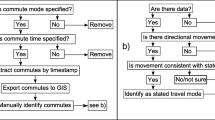Abstract
Research has been conducted to understand tourists’ spatio-temporal behaviours. However, it is very costly to investigate what the tourist was actually doing at each location and moment and what he/she was interested in Kawase et al. (When and where tourists are viewing exhibitions: Toward sophistication of GPS-assisted tourist activity surveys. Springer, Vienna, pp. 415–425, 2012) demonstrated the possibility that we can predict only from a tourist’s GPS log whether he/she is viewing an exhibition or not, which is one of the most basic activities in tourism. Following their work, we conduct an additional experiment two types of subjects, students and kindergarteners with parents, and refine the prediction model with additional explaining parameters. We found that the model for students could be successfully improved, while that for kindergarteners has a problem due to the inconsistency of their behaviour. In addition, we experimentally investigated the combined use of a GPS sensor and an accelerometer, both usually equipped in smartphones, for predicting tourists’ viewing state. The result shows that the combined use of these sensors seems promising to infer tourists’ activities.
Access this chapter
Tax calculation will be finalised at checkout
Purchases are for personal use only
Similar content being viewed by others
References
Akahori, A., Kishimoto, Y., & Oguri, K. (2005). A Study of estimation of actions using a three-axis acceleration sensor. IEIC Technical Report, 105(456), 49–52.
Asakura, Y., & Hato, E. (2004). Tracking survey for individual travel behaviour using mobile communication instruments. Transportation Research Part C: Emerging Technologies, 12(3–4), 273–291.
Asakura, Y., & Iryo, T. (2007). Analysis of tourist behaviour based on the tracking data collected using a mobile communication instrument. Transportation Research Part A: Policy and Practice, 41(7), 684–690.
Birenboim, A., Anton-Clavé, S., Russo, A. P., & Shoval, N. (2013). Temporal activity patterns of theme park visitors. Tourism Geographies, published online.
Intille, S. S., Bao, L., Tapia, E. M., & Rondoni, J. (2004). Acquiring in situ training data for context-aware ubiquitous computing applications. In SIGCHI Conference on Human factors in Computing Systems (pp. 1–8). ACM.
Kanda, T., Shiomi, M., Perrin, L., Nomura, T., Ishiguro, H., & Hagita, N. (2007). Analysis of people trajectories with ubiquitous sensors in a science museum. In Robotics and Automation, 2007 IEEE International Conference (pp. 4846–4853). IEEE.
Kawase, J., Kurata, Y., & Yabe, N. (2012). When and where tourists are viewing exhibitions: Toward sophistication of GPS-assisted tourist activity surveys. In ENTER 2012 (pp. 415–425). Springer Vienna.
Kern, N., Antifakos, S., Schiele, B., & Schwaninger, A. (2004). A model for human interruptability: Experimental evaluation and automatic estimation from wearable sensors. In International Symposium on Wearable Computers, 2004 (Vol. 1, pp. 158–165). IEEE.
Matsunami, H. (2007). Service science: Applications of observation to real world business. In 4th International Conference on Universal Access in Human-Computer Interaction (pp. 951–960). Berlin Heidelberg: Springer.
Miluzzo, E., Papandrea, M., Lane, N. D., Lu, H., & Campbell, A. T. (2010). Pocket, bag, hand, etc.-automatically detecting phone context through discovery. In PhoneSense 2010 (pp. 21–25).
Miyazaki, Y., Konishi, Y., Nakao, T., Koshiba, H., Aihara, K., and Takeda, H. (2010). M-066 in-store context estimation using sensors: Application of human and environmental sensing for development of e-Space. In Forum on Information Technology (Vol. 9(4), pp. 431–434). (In Japanese).
Nagao, M., Kawamura, H., Yamamoto, M., & Ohuchi, A. (2004). Acquisition of personal tourism activity information based on GPS log mining method. In Fifth Asia-Pacific Industrial Engineering and Management Systems Conference (CD-ROM).
Randell, C., & Muller, H. (2000). Context awareness by analysing accelerometer data. In Fourth International Symposium on Wearable Computers (pp. 175–176). IEEE.
Shoval, N. (2008). Tracking technologies and urban analysis. Cities, 25(1), 21–28.
Shoval, N., & Isaacson, M. (2007a). Tracking tourist in the digital age. Annals of Tourism Research, 34(2), 141–159.
Shoval, N., & Isaacson, M. (2007b). Sequence alignment as a method for human activity analysis. Annals of the Association of American Geographers, 97(2), 282–297.
Thornton, P. R., Williams, A. M., & Shaw, G. (1997). Revisiting time-space diaries: An exploratory case study of tourist behaviour in Cornwall. England. Environment and Planning A, 29(10), 1847–1867.
Yabe, N., Arima, T., Okamura, Y., & Kadono, A. (2010). An agenda on tourist activity survey using GPS and investigation of analysis methods. International Journal of Tourism Science, 3, 17–30. (In Japanese).
Yoshimura, Y., Girardin, F., Carrascal, J. P., Ratti, C., & Blat, J. (2012). New tools for studying visitor behaviours in museums: a case study at the Louvre. In ENTER 2012 (pp. 391–402). Springer Vienna.
Acknowledgments
We appreciate the visitors to Tama Zoological Park who participated in our surveys, as well as its staff who kindly helped our surveys and gave valuable comments to us.
Author information
Authors and Affiliations
Corresponding author
Editor information
Editors and Affiliations
Rights and permissions
Copyright information
© 2013 Springer International Publishing Switzerland
About this paper
Cite this paper
Kawase, J., Kurata, Y., Yabe, N. (2013). Predicting from GPS and Accelerometer Data When and Where Tourists Have Viewed Exhibitions. In: Xiang, Z., Tussyadiah, I. (eds) Information and Communication Technologies in Tourism 2014. Springer, Cham. https://doi.org/10.1007/978-3-319-03973-2_9
Download citation
DOI: https://doi.org/10.1007/978-3-319-03973-2_9
Published:
Publisher Name: Springer, Cham
Print ISBN: 978-3-319-03972-5
Online ISBN: 978-3-319-03973-2
eBook Packages: Business and EconomicsBusiness and Management (R0)




